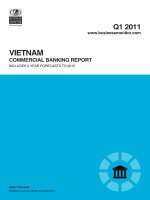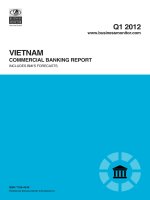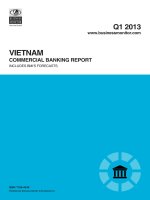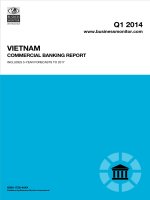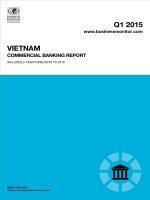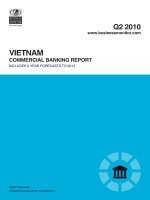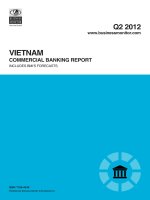Vietnam commercial banking report q3 2015
Bạn đang xem bản rút gọn của tài liệu. Xem và tải ngay bản đầy đủ của tài liệu tại đây (362.76 KB, 67 trang )
Q3 2015
www.bmiresearch.com
VIETNAM
COMMERCIAL BANKING REPORT
INCLUDES 5-YEAR FORECASTS TO 2019
ISSN 1758-454X
Published by:BMI Research
Vietnam Commercial Banking Report Q3
2015
INCLUDES 5-YEAR FORECASTS TO 2019
Part of BMI’s Industry Report & Forecasts Series
Published by: BMI Research
Copy deadline: May 2015
BMI Research
Senator House
85 Queen Victoria Street
London
EC4V 4AB
United Kingdom
Tel: +44 (0) 20 7248 0468
Fax: +44 (0) 20 7248 0467
Email:
Web:
© 2015 Business Monitor International Ltd
All rights reserved.
All information contained in this publication is
copyrighted in the name of Business Monitor
International Ltd, and as such no part of this
publication may be reproduced, repackaged,
redistributed, resold in whole or in any part, or used
in any form or by any means graphic, electronic or
mechanical, including photocopying, recording,
taping, or by information storage or retrieval, or by
any other means, without the express written consent
of the publisher.
DISCLAIMER
All information contained in this publication has been researched and compiled from sources believed to be accurate and reliable at the time of
publishing. However, in view of the natural scope for human and/or mechanical error, either at source or during production, Business Monitor
International Ltd accepts no liability whatsoever for any loss or damage resulting from errors, inaccuracies or omissions affecting any part of the
publication. All information is provided without warranty, and Business Monitor International Ltd makes no representation of warranty of any kind
as to the accuracy or completeness of any information hereto contained.
CONTENTS
BMI Industry View 7
Table: Commercial Banking Sector Indicators 7
Table: Commercial Banking Sector Key Ratios, October 2013 7
Table: Annual Growth Rate Projections 2014-2019 (%) 7
Table: Ranking Out Of 73 Countries Reviewed In 2015 8
Table: Commercial Banking Sector Indicators, 2012-2019 8
SWOT 9
Commercial Banking 9
Political 10
Economic 11
Operational Risk 13
Industry Forecast 15
Economic Analysis 15
Industry Risk Reward Ratings 18
Asia Commercial Banking Risk/Reward Index 18
Table: Asia Commercial Banking Risk/Reward Index 19
Market Overview 20
Asia Commercial Banking Outlook 20
Table: Banks' Bond Portfolios, 2013 20
Table: Comparison Of Loan/Deposit & Loan/Asset & Loan/GDP Ratios, 2015 20
Table: Comparison of Total Assets & Client Loans & Client Deposits (USDbn) 21
Table: Comparison Of USD Per Capita Deposits, 2015 22
Economic Analysis 23
Table: Economic Activity (Vietnam 2010-2019) 26
Competitive Landscape 27
Market Structure 27
Protagonists 27
Table: Protagonists In Vietnam's Commercial Banking Sector 27
Definition Of The Commercial Banking Universe 27
List Of Banks 28
Table: Financial Institutions In Vietnam 28
Company Profile 30
Agribank 30
Table: Balance Sheet (VNDmn) 32
Table: Balance Sheet (USDmn) 32
Table: Key Ratios (%) 32
Bank for Foreign Trade of Vietnam (Vietcombank) 33
Table: Stock Market Indicator 35
Vietnam Commercial Banking Report Q3 2015
© Business Monitor International Ltd Page 4
Table: Balance Sheet (VNDmn) 35
Table: Balance Sheet (USDmn) 36
Table: Key Ratios (%) 36
Eximbank 37
Table: Stock Market Indicators 39
Table: Balance Sheet (VNDmn) 39
Table: Balance Sheet (USDmn) 39
Table: Key Ratios (%) 40
Sacombank 41
Table: Stock Market Indicators 43
Table: Balance Sheet (VNDmn) 43
Table: Balance Sheet (USDmn) 43
Table: Key Ratios (%) 44
VietinBank 45
Table: Stock Market Indicators 47
Table: Balance Sheet (VNDmn) 47
Table: Balance Sheet (USDmn) 48
Table: Key Ratios (%) 48
Regional Overview 49
Asia Overview 49
Global Industry Overview 52
Global Commercial Banking Outlook 52
US And Eurozone Banking Outlook 52
Emerging Market Regional Outlooks 53
Demographic Forecast 57
Table: Population Headline Indicators (Vietnam 1990-2025) 58
Table: Key Population Ratios (Vietnam 1990-2025) 58
Table: Urban/Rural Population & Life Expectancy (Vietnam 1990-2025) 59
Table: Population By Age Group (Vietnam 1990-2025) 59
Table: Population By Age Group % (Vietnam 1990-2025) 60
Methodology 62
Industry Forecast Methodology 62
Sector-Specific Methodology 63
Risk/Reward Ratings Methodology 64
Table: Commercial Banking Risk/Reward Rating Indicators 65
Table: Weighting Of Indicators 66
Vietnam Commercial Banking Report Q3 2015
© Business Monitor International Ltd Page 5
BMI Industry View
Table: Commercial Banking Sector Indicators
Date
Total
assets
Client
loans
Bond
portfolio Other
Liabilities
and capital Capital
Client
deposits Other
October 2012, VNDbn 3,688,076 2,938,250 355,697 394,129 3,688,076 583,666 2,861,204 243,206
October 2013, VNDbn 4,257,985 3,309,020 502,944 446,021 4,257,985 636,710 3,580,465 40,810
% change y-o-y 15.5% 12.6% 41.4% 13.2% 15.5% 9.1% 25.1% -83.2%
October 2012, USDbn 176.9 140.9 17.1 18.9 176.9 28.0 137.2 11.7
October 2013, USDbn 201.8 156.8 23.8 21.1 201.8 30.2 169.7 1.9
% change y-o-y 14.1% 11.3% 39.7% 11.8% 14.1% 7.8% 23.7% -83.4%
Source: BMI; Central banks; Regulators
Table: Commercial Banking Sector Key Ratios, October 2013
Loan/deposit ratio
Loan/asset ratio Loan/GDP ratio GDP Per Capita, USD Deposits per capita, USD
92.42% 77.71% 93.8% 2,007.2 1,853.9
Falling Falling Falling na na
na = not available. Source: BMI; Central banks; Regulators
Table: Annual Growth Rate Projections 2014-2019 (%)
Assets Loans Deposits
Annual Growth Rate 10 8 5
CAGR 11 9 6
Ranking 22 29 44
Source: BMI; Central banks; Regulators
Vietnam Commercial Banking Report Q3 2015
© Business Monitor International Ltd Page 7
Table: Ranking Out Of 73 Countries Reviewed In 2015
Loan/deposit ratio Loan/asset ratio Loan/GDP ratio
16 4 17
Local currency asset growth Local currency loan growth Local currency deposit growth
19 25 29
Source: BMI; Central banks; Regulators
Table: Commercial Banking Sector Indicators, 2012-2019
2012 2013 2014e 2015f 2016f 2017f 2018f 2019f
Total assets, VNDbn 3,917,557 4,466,015 5,091,257 5,753,121 6,443,495 7,152,280 7,939,030 8,759,397
Total assets, USDbn 188.0 211.7 238.0 267.0 301.8 338.2 379.0 422.1
Client loans, VNDbn 3,077,700 3,447,024 3,860,667 4,285,340 4,713,874 5,138,123 5,600,554 6,067,267
Client loans, USDbn 147.7 163.4 180.5 198.9 220.8 242.9 267.3 292.4
Client deposits, VNDbn 3,080,455 3,388,501 3,693,466 3,988,943 4,268,169 4,524,259 4,795,715 5,051,486
Client deposits, USDbn 147.8 160.6 172.7 185.1 199.9 213.9 228.9 243.4
e/f = estimate/forecast. Source: BMI; Central banks; Regulators
Vietnam Commercial Banking Report Q3 2015
© Business Monitor International Ltd Page 8
SWOT
Commercial Banking
Vietnam Commercial Banking SWOT
Strengths
■
Untapped market with potential for increased participation of foreign banks.
■
Large population with a high savings rate and potential for income growth.
■
The Vietnamese government aims to speed up the process of privatising state-owned
banks, which will help modernise the industry.
■
State-owned banks will gradually play a lesser role going forward, and the risks
associated with state-directed lending will decrease over time.
Weaknesses
■
Domestic banks continue to lag behind their foreign peers in terms of financial
strength and the technological curve.
■
Accounting standards lag behind international standards and the lack of transparency
entails significant risks for foreign investors.
■
Small banks have an overwhelming exposure to real estate and individual loans,
resulting in highly skewed and risky loan portfolios.
Opportunities
■
The country remains one of the most under-banked in the region, with significant
potential for adopting cash-free payment systems and new mobile banking
technologies.
■
Rising income levels and deepening capital markets could give rise to opportunities in
more sophisticated financial products and growth for the local asset management
industry.
Threats
■
Track record of macroeconomic instability threatens the credibility of the government
and could potentially drive economic policy away from further liberalisation.
■
The high level of government debt risks triggering a fiscal crisis, undermining
confidence in the banking sector.
Vietnam Commercial Banking Report Q3 2015
© Business Monitor International Ltd Page 9
Political
SWOT Analysis
Strengths
■
The Communist Party of Vietnam remains committed to market-oriented reforms and
we do not expect major shifts in policy direction over the next five years. The one-
party system is generally conducive to short-term political stability.
■
Relations with the US have witnessed a marked improvement, and Washington sees
Hanoi as a potential geopolitical ally in South East Asia.
Weaknesses
■
Corruption among government officials poses a major threat to the legitimacy of the
ruling Communist Party.
■
There is increasing (albeit still limited) public dissatisfaction with the leadership's tight
control over political dissent.
Opportunities
■
The government recognises the threat corruption poses to its legitimacy, and has
acted to clamp down on graft among party officials.
■
Vietnam has allowed legislators to become more vocal in criticising government
policies. This is opening up opportunities for more checks and balances within the
one-party system.
Threats
■
Although strong domestic control will ensure little change to Vietnam's political scene
in the next few years, over the longer term, the one-party-state will probably be
unsustainable.
■
Relations with China have deteriorated over recent years due to Beijing's more
assertive stance over disputed islands in the South China Sea and domestic criticism
of a large Chinese investment into a bauxite mining project in the central highlands,
which could potentially cause wide-scale environmental damage.
Vietnam Commercial Banking Report Q3 2015
© Business Monitor International Ltd Page 10
Economic
SWOT Analysis
Strengths
■
Vietnam has been one of the fastest-growing economies in Asia in recent years, with
GDP growth averaging 6.6% annually between 2000 and 2013.
■
The economic boom has lifted many Vietnamese out of poverty, with the official
poverty rate in the country falling from 58% in 1993 to 17.2% in 2012.
■
Vietnam has been strengthening its trade and aid ties in a bid to increase exports and
diversify its export sector.
Weaknesses
■
Vietnam still suffers from fiscal deficits, leaving the economy vulnerable to global
economic uncertainties. The fiscal deficit is dominated by substantial spending on
social subsidies that could be difficult to withdraw.
■
The heavily-managed and weak currency reduces incentives to improve quality of
exports, and also keeps import costs high, contributing to inflationary pressures.
Opportunities
■
WTO membership and the upcoming ASEAN economic integration in 2015 should
give Vietnam greater access to both foreign markets and capital, while making
Vietnamese enterprises stronger through increased foreign competition.
■
The government has continued to move forward with market reforms, including
privatisation of state-owned enterprises, addressing the high level of bad loans in the
banking sector as well as liberalising the banking sector.
■
Urbanisation will continue to be a long-term growth driver. The UN forecasts the
urban population rising from 32% of the population in 2013 to more than 50% by the
early 2040s.
Threats
■
Although inflation has subsided in 2014, complacency by the State Bank of Vietnam
on this front could result in a decline in investment.
■
The potential for an escalation of political tensions with China over sovereign claims
to parts of the South China Sea could have a negative impact on the economy.
Vietnam Commercial Banking Report Q3 2015
© Business Monitor International Ltd Page 11
SWOT Analysis - Continued
■
Market reforms could progress at a much slower pace as the government remains
cautious about ceding ownership to foreign investors.
Vietnam Commercial Banking Report Q3 2015
© Business Monitor International Ltd Page 12
Operational Risk
SWOT Analysis
Strengths
■
Vietnam has a high number of university graduates with skilled degrees and a high
literacy rate for its income level.
• In addition to a number of regional and international flight options, Vietnam has an
extensive inland waterway system.
■
Strong contract enforcement capabilities increase security.
• Vietnam's rate of violent crime is generally low, and foreigners are unlikely to be
targeted.
Weaknesses
■
High labour costs increase overall operating costs, and difficulty in hiring foreigners
creates shortages of skilled labour.
• Underdeveloped rail capacity overburdens the road network.
• One of the worst tax administration systems in Asia.
• The police force is under-equipped and under-resourced in many areas.
Opportunities
■
Fairly high expenditures in secondary education by regional standards will help close
gaps in access to education.
• Vietnam is easily accessible from the main shipping routes, and growth in the number
of port facilities will provide adequate capacity.
• Declining trade barriers are making it easier to enter the market.
• Increased foreign participation in the banking sector will increase the availability of
funds for loans.
Threats
■
Unequal access to secondary education will result in a lower-quality workforce in
poorer regions.
• Vietnam's reliance on imported oil poses risks in the form of energy and fuel
shortages.
Vietnam Commercial Banking Report Q3 2015
© Business Monitor International Ltd Page 13
SWOT Analysis - Continued
• Corruption and inefficiency in the legal system.
• Anti-Chinese violence, as seen in May 2014, could be a harbinger of wider political
and social unrest.
Vietnam Commercial Banking Report Q3 2015
© Business Monitor International Ltd Page 14
Industry Forecast
Economic Analysis
BMI View: While the Vietnamese banking sector remains burdened by bad debts and the still-strong
presence of state enterprises, sustained rapid economic growth momentum and ongoing banking reform
efforts by the government should gradually strengthen the local banks. The retail banking segment will be a
key growth engine over the coming years owing to the relatively under-banked nature of the country.
Vietnam's banking sector remains relatively underdeveloped and immature in the region. State-owned
commercial banks remain dominant, accounting for around 45% of the entire sector. The sector's asset-to-
GDP ratio, at an estimated 129.3% in 2014, also underperforms the regional average. Meanwhile,
Vietnamese banks remain burdened by high levels of bad debt, owing to a combination of excessively rapid
credit expansion during the last decade, the lack of proper credit risk assessment, as well as the weak
framework for loan reporting and classification. While government estimates place the country's non-
performing loan ratio at around 4%, rating agency Moody's projects the metric to be at 15.0%. However, it
is not all doom and gloom for the sector, as continued strong economic growth momentum and the ongoing
banking reforms by the government should eventually lead to a strengthening of Vietnamese banks over the
coming years. Accordingly, we forecast the sector's growth in terms of its asset-to-GDP ratio to average
11.5% annually over the period from 2015 to 2019.
Vietnam Commercial Banking Report Q3 2015
© Business Monitor International Ltd Page 15
Room For Expansion
Asia (Excluding Hong Kong) - Asset-To-GDP Ratio, %
Source: National Sources, BMI
Strong Economic Growth Informs Healthy Loan Expansion Outlook
Robust economic growth in Vietnam on the back of rising foreign direct investment inflows and continued
strong export sector growth will bode well for loan expansion in the country. In a harbinger of continued
real GDP growth momentum over the coming quarters, realised foreign registered capital inflows rose 5.0%
year-on-year (y-o-y) to USD4.2bn in the first four months of 2015. On the export front, Vietnamese
outbound shipments (which account for about 80% of nominal GDP) rose by 8.2% y-o-y over the same
period despite headwinds from regional economic weakness, particularly in China. Consequently, we
maintain our forecast for real GDP growth to accelerate to 6.4% in 2015 from 6.0% in the previous year.
Meanwhile, we project loan growth of 11.0% in 2015, in line with our positive economic outlook for the
Vietnamese economy. Sustained credit expansion will in turn bolster banks' earnings growth.
Retail Banking A Key Growth Segment
We believe a key growth area that Vietnamese banks can tap into over the coming years is in the retail
banking segment. Indeed, Vietnam remains one of the most under-banked countries in the region despite
Vietnam Commercial Banking Report Q3 2015
© Business Monitor International Ltd Page 16
recent rapid economic growth. According to the World Bank, the country's banking penetration rate stood at
just 21.4% in 2011, among the lowest in the region. In combination with the rising affluence of the
Vietnamese people, with GDP per capita set to rise to USD3,644 by 2020 from USD2,007 in 2014
according to our forecast, there is therefore huge room for growth in the retail banking segment.
SOE Reform A Positive Step…
Ongoing state-owned enterprise (SOE) reform undertaken by the government is also a positive development
towards creating a free market economy and relieving the banking sector from bad debt burdens. Indeed,
SOEs reportedly accounted for about 60% of the country's total loan portfolio and more than half of the
nation's bad debts. Privatising these state-owned enterprises should help lead to improved operational
efficiencies, shoring up profits and reducing their borrowing needs.
…But Will Be A Gradual Process
While ongoing reforms will bode well for the banking sector, this will be a very gradual process. We
believe the government has been far too ambitious with its aim to privatise about 280 state firms (largely
conglomerates) in 2015. Indeed, the government reportedly only privatised less than 10% of its target in
Q115. Moreover, only minority stakes of state-owned companies were sold, reflecting reluctance by the
government to cede control to foreign investors. It is therefore hardly surprising that these share sales over
recent quarters have largely failed to attract foreign investor interest.
Vietnam Commercial Banking Report Q3 2015
© Business Monitor International Ltd Page 17
Industry Risk Reward Ratings
Asia Commercial Banking Risk/Reward Index
Commercial Banking Risk/Reward Index Methodology
Since Q108, we have described numerically the banking business environment for each of the countries
analysed by BMI. We do this through our Commercial Banking Industry Risk/Reward Index (RRI), a
measure that ensures we capture the latest quantitative information available. It also ensures consistency
across all countries. Like all of BMI's RRIs, its takes into account the Rewards on offer within the banking
sector in a given country, but also the Risks to investors being able to realise those opportunities. The
overall index is weighted 70% towards Rewards and 30% towards Risks.
Within the Rewards category, we look at factors that are specific to the banking industry (accounting for
60% of the score within this category), and elements that relate to that country in general (accounting for
40% of the weighting). These include, but are not limited to, total assets, asset and loan growth, GDP and
taxation. Likewise on the Risks side, we look at industry-specific Risks (weighted 40% of the Risks total)
and country-specific Risks (weighted 60%). These include, but are not limited to, the regulatory framework
and environment, the competitive environment, financial risk, legal risk and policy continuity.
In general three aspects need to be borne in mind when interpreting the RRIs. The first is that the Industry
Rewards element is the most heavily weighted of the four elements, accounting for 42% (60% of 70%) of
the overall Index. Second, if the Industry Rewards score is significantly higher than the Country Rewards
score, within the Rewards category, it usually implies that the banking sector is (very) large and/or
developed relative to the general wealth, stability and financial infrastructure in the country. Conversely, if
the industry score is significantly lower, it usually means that the banking sector is small and/or
underdeveloped relative to the general wealth, stability and financial infrastructure in the country. Third,
within the Risks category, the industry-specific elements (i.e. how regulations affect the development of the
sector, how regulations affect competition within it, and Moody's Investor Services' Ratings for local
currency deposits) can be markedly different from BMI's long-term Country Risk Index for a given market.
Vietnam Commercial Banking Report Q3 2015
© Business Monitor International Ltd Page 18
Table: Asia Commercial Banking Risk/Reward Index
Limits of Potential Returns Risks to Potential Returns Overall
Market Structure Country Structure Market Risks Country Risks Index Ranking
Bangladesh 56.7 47.5 43.3 46.0 50.6 51
China 93.3 57.5 63.3 70.0 75.5 15
Hong Kong 80.0 95.0 73.3 80.0 83.4 4
India 83.3 57.5 60.0 56.0 68.4 26
Indonesia 73.3 65.0 80.0 54.0 68.3 27
Japan 33.3 75.0 66.7 78.0 57.0 40
Malaysia 73.3 80.0 83.3 76.0 76.9 11
Pakistan 50.0 50.0 53.3 46.0 49.7 54
Philippines 53.3 62.5 60.0 62.0 58.3 38
Singapore 66.7 95.0 96.7 84.0 81.3 8
Sri Lanka 33.3 57.5 33.3 52.0 43.5 63
South Korea 76.7 85.0 83.3 78.0 80.0 10
Taiwan 76.7 72.5 86.7 74.0 76.2 12
Thailand 66.7 65.0 86.7 70.0 69.2 22
Vietnam 60.0 57.5 36.7 56.0 55.8 41
New Zealand 43.3 87.5 86.7 82.0 67.9 29
United States 93.3 85.0 100.0 82.0 89.8 2
Scores out of 100, with 100 the highest. Source: BMI
Vietnam Commercial Banking Report Q3 2015
© Business Monitor International Ltd Page 19
Market Overview
Asia Commercial Banking Outlook
Table: Banks' Bond Portfolios, 2013
Bond Portfolio, USDbn Bond as % total assets Year-on-year growth %
Bangladesh 26.8 25.8 30.5
China* 1,873.0 8.7 17.5
Hong Kong* 379.3 19.8 8.1
India 357.2 26.0 13.9
Indonesia** 17.3 4.3 17.7
Japan 2,456.3 28.0 -4.5
Malaysia 77.8 12.8 -4.6
Pakistan 40.4 42.7 5.9
Philippines 42.7 21.1 8.0
Singapore 93.2 12.1 5.4
Sri Lanka 7.5 22.7 51.2
South Korea 268.7 15.2 -10.2
Taiwan 209.1 15.6 86.4
Thailand 80.4 16.3 4.7
Vietnam* 20.4 10.9 64.4
New Zealand 11.8 3.5 -9.0
United States 486.5 3.5 -8.5
Source: Central banks, regulators, BMI. **Only 2011 data available. * Only 2012 data available.
Table: Comparison Of Loan/Deposit & Loan/Asset & Loan/GDP Ratios, 2015
Loan/Deposit
ratio % Rank Trend
Loan/Asset
ratio % Rank Trend
Loan/GDP
ratio % Rank Trend
Bangladesh 85.8 48 Rising 63.9 22 Falling 45.3 51 Rising
China 87.0 52 Rising 51.7 49 Rising 146.8 9 Rising
Hong Kong 72.7 63 Rising 38.7 66 Rising 317.9 1 Rising
India 76.9 58 Falling 67.6 12 Falling 59.0 44 Rising
Indonesia 77.5 45 Falling 64.1 16 Falling 34.2 58 Falling
Japan 67.3 65 Falling 47.6 54 Falling 90.5 20 Falling
Vietnam Commercial Banking Report Q3 2015
© Business Monitor International Ltd Page 20
Comparison Of Loan/Deposit & Loan/Asset & Loan/GDP Ratios, 2015 - Continued
Loan/Deposit
ratio % Rank Trend
Loan/Asset
ratio % Rank Trend
Loan/GDP
ratio % Rank Trend
Malaysia 72.7 61 Falling 60.1 31 Falling 116.8 13 Falling
Pakistan 61.0 68 Rising 44.1 60 Falling 21.5 66 Rising
Philippines 70.6 67 Rising 53.2 48 Rising 40.9 54 Rising
Singapore 104.9 14 Falling 58.2 39 Falling 158.0 6 Rising
Sri Lanka 81.0 55 Rising 58.9 37 Falling 33.5 62 Rising
South Korea 126.1 4 Falling 74.3 6 Rising 97.8 17 Rising
Taiwan 81.1 56 Rising 63.2 28 Rising 162.0 7 Rising
Thailand 98.2 27 Falling 67.0 14 Rising 93.3 19 Rising
Vietnam 107.4 19 Rising 74.5 4 Falling 100.2 16 Rising
New Zealand 192.5 1 Rising 89.5 1 Rising 157.7 8 Falling
United States 104.8 20 Rising 73.1 7 Rising 64.5 37 Rising
Source: Central banks, regulators, BMI
Table: Comparison of Total Assets & Client Loans & Client Deposits (USDbn)
2015 2014
Total Assets Client Loans Client Deposits Total Assets Client Loans Client Deposits
Bangladesh 137.5 87.9 102.4 117.8 75.3 89.5
China 30,895.9 15,973.3 18,364.4 28,482.3 14,213.3 17,400.0
Hong Kong 2,538.6 983.4 1,352.3 2,377.2 938.4 1,266.3
India 1,876.5 1,268.9 1,651.1 1,589.2 1,074.6 1,374.9
Indonesia 461.7 296.1 381.9 455.9 297.7 352.0
Japan 8,079.4 3,844.9 5,714.4 7,880.6 3,787.8 5,519.1
Malaysia 606.5 364.6 501.6 602.5 362.1 475.9
Pakistan 126.4 55.7 90.9 110.6 48.8 81.4
Philippines 238.1 126.5 179.3 218.3 109.5 165.1
Singapore 774.3 450.5 429.6 800.0 458.7 415.2
Sri Lanka 45.2 26.6 32.8 39.2 23.1 28.9
South Korea 1,846.1 1,371.3 1,087.2 1,781.3 1,310.5 1,034.1
Taiwan 1,367.6 864.9 1,066.7 1,308.5 805.1 1,020.6
Thailand 540.6 362.1 368.7 516.3 344.2 350.4
Vietnam 267.0 198.9 185.1 238.0 180.5 172.7
Vietnam Commercial Banking Report Q3 2015
© Business Monitor International Ltd Page 21
Comparison of Total Assets & Client Loans & Client Deposits (USDbn) - Continued
2015 2014
New Zealand 302.7 271.0 140.8 330.5 293.0 153.7
United States 16,025.1 11,715.1 11,174.9 15,047.1 10,897.8 10,542.4
Source: Central banks, regulators, BMI
Table: Comparison Of USD Per Capita Deposits, 2015
GDP Per Capita
Client Deposits, per
capita
Rich 20% Client
Deposits, per capita
Poor 80% Client
Deposits, per capita
Bangladesh 1,222 638 2,554 160
China 7,853 13,103 52,410 3,276
Hong Kong 42,301 184,902 739,609 46,226
India 1,683 1,288 5,150 322
Indonesia 3,511 1,494 5,974 373
Japan 33,209 45,060 180,240 11,265
Malaysia 10,183 16,364 65,458 4,091
Pakistan 1,390 483 1,934 121
Philippines 3,035 1,761 7,044 440
Singapore 50,740 76,455 305,819 19,114
Sri Lanka 3,673 1,520 6,079 380
South Korea 28,184 21,853 87,413 5,463
Taiwan 22,562 45,448 181,792 11,362
Thailand 5,800 5,470 21,878 1,367
Vietnam 2,134 1,982 7,928 496
New Zealand 38,459 30,625 122,501 7,656
United States 53,574 34,371 137,484 8,593
Source: Central banks, regulators, BMI
Vietnam Commercial Banking Report Q3 2015
© Business Monitor International Ltd Page 22
Economic Analysis
BMI View: We expect continued strong foreign direct investment, healthy export growth and ongoing
efforts by the government to improve macroeconomic fundamentals to keep the Vietnamese economy
growing strongly in 2015. Consequently, we forecast Vietnam's real GDP growth to accelerate to 6.4% in
2015, from 6.0% in 2014.
In line with our bullish economic outlook for Vietnam, the country's real GDP growth accelerated to an
impressive 7.0% in Q414 from the revised 6.1% in the previous quarter. This in turn brought real GDP
expansion for the year to 6.0%, surpassing the Bloomberg consensus estimate of 5.7% and marking
Vietnam as one of the brightest growth spots in Asia. We expect Vietnam's robust economic growth
momentum in 2014 to be carried over into 2015, largely on the back of greater foreign direct investment
(FDI) inflows, continued healthy export growth as well as continual efforts by the Vietnamese government
to improve macroeconomic fundamentals. As such, we forecast the Vietnamese economy to continue
growing at a strong pace of 6.4% in real terms in 2015.
Strong Economic Expansion On The Cards
Vietnam - Real GDP Growth, %
Source: BMI, GSO
Vietnam Commercial Banking Report Q3 2015
© Business Monitor International Ltd Page 23
FDI And Exports To Continue Driving Growth
From an expenditure approach, the strong showing in 2014 owes largely to high foreign investor interest
towards the country and the robust performance in the export sector. Latest data published by the General
Statistics Office showed that total foreign registered capital rose 9.6% to USD15.6bn in 2014, with the
manufacturing sector receiving the bulk of it (71.6%). While there is the potential for volatility in emerging
and frontier markets as the US looks to tighten its monetary policy over the coming quarters, we
nevertheless expect a continuation of strong FDI inflows to Vietnam. This is corroborated by our view that
Vietnam can continue to attract foreign investors, particularly manufacturing firms, as it offers them
attractively low wages, strong demographics that will ensure a continual supply of workers as well as
generous tax incentives.
Meanwhile, exports grew by 13.6% to approximately USD150.0bn over the course of 2014. Given the
country's export orientation to the US, which received about 19% of total Vietnamese outbound shipments
in 2014, a recovering US economy will bode well for the export sector going forward.
Manufacturing And Services Sectors To Remain Strong
From a production perspective, broad-based growth was witnessed in 2014. Notably, the manufacturing
sector rose by 8.5%, while construction grew by 7.1%. The service industry also posted robust growth of
6.0%. Over the coming quarters, we expect the Vietnamese economy to continue riding on strong
manufacturing performances. The Purchasing Managers' Index, a leading measure of manufacturing
performance, points to higher production activity. Indeed, the index came in at 52.7 in December 2014,
marking the 16th consecutive month of expansion. In addition, continued FDI inflows to the sector will also
help to keep factories running at high capacity utilisation.
In addition to the manufacturing sector, we are also optimistic about the prospects of Vietnam's real estate
and construction sectors. The easing of foreign property ownership rules, which will take effect in July
2015, should act as a catalyst to attract more foreign demand for domestic properties (see 'Easing Of
Foreign Property Ownership Rules A Positive Step Forward', December 2, 2014). Since the construction
sector is strongly correlated with the property market, we expect the former to continue putting in a strong
performance over the coming quarters as well. That said, we note that business environment weakness could
weigh on foreign participation in realty investment in the near term.
Vietnam Commercial Banking Report Q3 2015
© Business Monitor International Ltd Page 24
Improving Macroeconomic Fundamentals Bode Well For Growth
Ongoing efforts by the Vietnamese government to strengthen macroeconomic fundamentals and to forge
financial stability following several economic missteps should also bode well for the economy. The
economy has witnessed a rapid decline in inflation, which is further aided by the slump in global oil prices
in H214. Consumer price inflation came in at a modest 1.8% year-on-year (y-o-y) in December 2014, down
from 2.6% y-o-y in the previous month and marking a long way down from its peak of 23.0% recorded in
August 2011. We expect price pressures to remain subdued over the coming months, owing in part to lower
commodity prices. As such, we forecast average inflation to come in at 2.1% in 2015, down from our initial
estimate of 5.3%. The government has also sought to address the high level of bad debt in the banking
system via the Vietnam Asset Management Company (VAMC). The VAMC, established in July 2013,
will purchase toxic assets from local banks and sell them thereafter in a bid to allow these institutions to
undergo much needed restructuring.
Price Pressures To Remain Subdued
Vietnam - Headline Inflation, % chg y-o-y
Source: BMI, GSO
Vietnam Commercial Banking Report Q3 2015
© Business Monitor International Ltd Page 25

